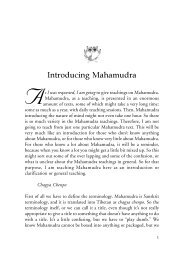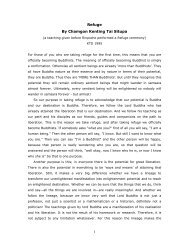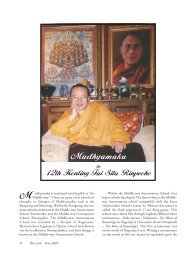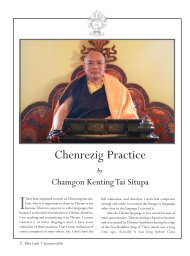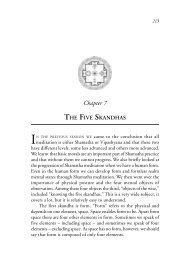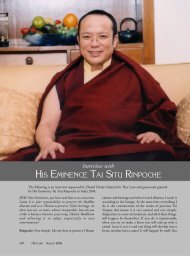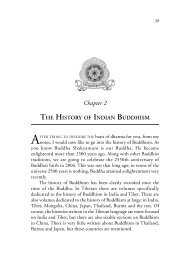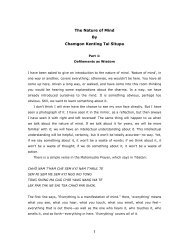Kenting Tai Situ Rinpoche - Zhyisil Chokyi Ghatsal
Kenting Tai Situ Rinpoche - Zhyisil Chokyi Ghatsal
Kenting Tai Situ Rinpoche - Zhyisil Chokyi Ghatsal
Create successful ePaper yourself
Turn your PDF publications into a flip-book with our unique Google optimized e-Paper software.
AVALOKITESHVARA<br />
PRACTICE<br />
<strong>Kenting</strong> <strong>Tai</strong> <strong>Situ</strong> <strong>Rinpoche</strong><br />
Avalokiteshvara is a bodhisattva<br />
because he said so. He took a vow not<br />
to attain enlightenment until the last<br />
sentient being attained enlightenment;<br />
that is, to remain as a bodhisattva<br />
forever. This action was also symbolic<br />
as it represented compassion.<br />
I am going to explain one of the practices of the bodhisattva<br />
Avalokiteshvara (Chenrezig). Avalokiteshvara is a bodhisattva because<br />
he said so. He took a vow not to attain enlightenment until<br />
the last sentient being attained enlightenment; that is, to<br />
remain as a bodhisattva forever. This action was also<br />
symbolic as it represented compassion. Compassion is only<br />
relevant until the last sentient being attains Buddhahood.<br />
We do not need compassion for Buddhas – we need devotion<br />
to them. If I were to write a letter to Buddha I would not<br />
sign off, “Yours sincerely, with compassion, <strong>Tai</strong> <strong>Situ</strong>.” I<br />
would write “Yours sincerely, with devotion, <strong>Tai</strong> <strong>Situ</strong>.”<br />
Compassion becomes irrelevant only when the last sentient<br />
being reaches Buddhahood. This means Avalokiteshvara,<br />
as a representation of compassion, is relevant until the last<br />
sentient being reaches Buddhahood.<br />
These are the two aspects of Avalokiteshvara. He is not just one<br />
person called Avalokiteshvara who decided not to become a Buddha<br />
until all sentient beings have reached Buddhahood. He is also the<br />
symbolic representation of compassion. We describe Avalokiteshvara<br />
as the father of all the Buddhas because compassion is the father of all<br />
the Buddhas.<br />
2 Thar Lam AUGUST 2006
There are many Avalokiteshvara practices: two-armed<br />
Avalokiteshvara, four-armed Avalokiteshvara, thousandarmed<br />
Avalokiteshvara, red Avalokiteshvara, white<br />
Avalokiteshvara, and many more. The great goddesses<br />
White and Green Tara, along with the twenty-one Taras,<br />
are manifestations of Avalokiteshvara and Wangchuk<br />
Chenpo (Mahashevara, Shiva), the great god of<br />
Hinduism, is also described as a manifestation of<br />
Avalokiteshvara. In our prayer we say “Chenrezig tu wang<br />
chug lha chenpo,” “The manifestation of<br />
Avalokiteshvara, the great god Shivaji.”<br />
The thousand-armed Avalokiteshvara came about<br />
because many eons after taking his vow, through his<br />
wisdom, Avalokiteshvara assessed how many beings had<br />
already attained Buddhahood and how many were still<br />
suffering in samsara. The sentient beings suffering in<br />
samsara were countless and the beings who had attained<br />
Buddhahood were also countless. The sentient beings<br />
suffering in samsara were hopeless though, and seeing<br />
this Avalokiteshvara became discouraged and almost<br />
broke his vow. Now originally, when he had taken his<br />
vow, he had promised that if he broke his vow his body<br />
would fall into a thousand pieces so when he became<br />
discouraged this is exactly what happened, his body broke<br />
into a thousand pieces.<br />
Through the blessings of all the Buddhas and<br />
bodhisattvas, however, he was transformed into his<br />
thousand-eyed, thousand-armed form. The thousand eyes<br />
represent a thousand Buddhas, and the thousand arms<br />
represent a thousand Chakravartins, universal monarchs<br />
who are the patrons of the Buddhas. This is the way the<br />
thousand-armed Avalokiteshvara manifested.<br />
Another time, when Avalokiteshvara again gazed on<br />
all sentient beings and saw how many countless sentient<br />
beings were suffering in samsara, he shed two tears. These<br />
two tears transformed into Green and White Tara, two<br />
manifestations of Avalokiteshvara. They vowed to play<br />
the role of enlightened mother to all sentient beings,<br />
helping them to attain Buddhahood and fulfill<br />
Avalokiteshvara’s original aspiration. Green Tara and the<br />
twenty-one Taras manifest to help sentient beings, in<br />
particular to liberate them from types of fear or aspects of<br />
Thar Lam AUGUST 2006 3
suffering. This is the Anuttarayoga aspect of<br />
Avalokiteshvara.<br />
I believe that many people in East Asia consider<br />
Avalokiteshvara to have a female form and be white in<br />
color. I can’t be a hundred percent sure but I presume this<br />
is White Tara, a manifestation of Avalokiteshvara. To be<br />
sure you would have to go to a lineage master of that<br />
particular practice, scholars and many other people. I am<br />
drawing conclusions here, because I have no authority<br />
and don’t know for sure, but for me this is what Kuan-<br />
Yin is, White Tara, Avalokiteshvara in female form.<br />
Avalokiteshvara’s practices, as with all dharma<br />
practices, have three parts. The first of these is refuge and<br />
bodhichitta. We have to focus on refuge and bodhichitta<br />
every time we practice, otherwise we may forget the<br />
purpose of our practice. To make sure we know clearly<br />
why we are doing a practice we start by saying the refuge<br />
and bodhisattva prayers. These two prayers together make<br />
up four simple sentences. These two sentences are the<br />
refuge prayer:<br />
Until I reach enlightenment,<br />
I take refuge in all the Buddhas,<br />
And in the dharma and all the noble sangha.<br />
The next two sentences are the bodhichitta prayer:<br />
By the merit of accomplishing the six perfections,<br />
May I achieve Buddhahood for the benefit of all<br />
sentient beings.<br />
Bodhichitta is peace. Sometimes I feel people<br />
misunderstand, or do not understand clearly, the difference<br />
between basic compassion and bodhichitta. If you are able<br />
to spend a few hours doing something for somebody you<br />
don’t even know people might call you a bodhisattva. They<br />
may say, “Oh, he or she is so kind, they are a bodhisattva.”<br />
This is not necessarily so. A kind person is not necessarily<br />
a bodhisattva. Being kind is very good, being a<br />
compassionate person is very good, but it does not<br />
necessarily make us a bodhisattva. A bodhisattva has to<br />
be kind and compassionate for a reason. A bodhisattva is<br />
kind and compassionate in that they are working to<br />
establish all beings as Buddhas. In this way bodhichitta is<br />
very specific.<br />
As a Vajrayana Buddhist whose ultimate aim is to<br />
reach Buddhahood, not just nirvana but Buddhahood,<br />
we must have bodhichitta. We cannot attain Buddhahood<br />
unless we wish to attain Buddhahood. We cannot attain<br />
it by mistake or accident. It has to happen intentionally.<br />
The intention must be to become a Buddha for the benefit<br />
of all sentient beings. If I were to wish to become a Buddha<br />
just for my own reasons, it would never happen. This<br />
intention would make my Buddhahood limited, private,<br />
but Buddhahood cannot be limited. By definition Buddha<br />
is limitless. This means that Buddhahood has to be<br />
attained by a limitless purpose – the limitless freedom<br />
and liberation of limitless sentient beings. Bodhichitta,<br />
therefore, must be focused on enlightenment in this way.<br />
The next section of the practice is the visualization of<br />
the four-armed Avalokiteshvara.<br />
On the crown of my head and that of all sentient<br />
beings pervading space,<br />
On a moon, on a lotus, is a HRI.<br />
From the HRI on the lotus appears the Noble<br />
one, Chenrezig.<br />
He radiates clear white light.<br />
He gazes with compassionate eyes and a loving smile.<br />
He has four hands. The first two are joined in prayer.<br />
The lower two hold a crystal rosary and white lotus.<br />
He is arrayed with silk and jewels.<br />
He wears an upper robe of doeskin.<br />
His head ornament is Amitabha, Buddha of<br />
Boundless Light.<br />
His legs are in the vajra posture.<br />
A stainless moon is his backrest.<br />
He is the essence of all those in whom we take refuge.<br />
Following the refuge and bodhichitta prayer we<br />
visualize Avalokiteshvara. On the crown of our head, and<br />
the heads of all sentient beings pervading space, there rests<br />
a white lotus and moon disc. Standing on the moon disc<br />
is a HRI, a syllable letter: from this HRI comes the noble<br />
supreme Avalokiteshvara. He is luminous white, radiating<br />
five-colored light and grace. He is smiling charmingly,<br />
with compassion, and gazing at sentient beings with<br />
compassionate eyes. He has four arms; the upper two are<br />
joined together and the lower two hold a white lotus and<br />
crystal mala. He is beautifully adorned by precious jewels<br />
and silks. A deerskin that symbolizes compassion covers<br />
his upper body, worn over his left shoulder.<br />
Some people have a hard time understanding why a<br />
4 Thar Lam AUGUST 2006
deer skin should represent compassion, but the particular<br />
deer whose skin Avalokiteshvara wears was a bodhisattva<br />
manifesting as a deer who sacrificed his life for the benefit<br />
of all sentient beings. Hence this deerskin represents<br />
compassion. It is not as if the deer was killed and<br />
Avalokiteshvara is now wearing its skin.<br />
Avalokiteshvara’s crown jewel is the Buddha<br />
Amitabha. He actually has five crowns representing all<br />
five Buddha families, but on top of these is the Buddha<br />
Amitabha. Avalokiteshvara sits in the vajra asana and a<br />
stainless moon supports his back. This means there are<br />
two crystal moon discs in this visualization: one is used as<br />
the seat underneath him and the other behind him as a<br />
backrest. Avalokiteshvara, in this basic visualization, is<br />
the essence of all sources of refuge.<br />
This is this practice’s main visualization. Following<br />
this visualization, we praise the Lord Avalokiteshvara:<br />
Oh Lord of whitest form, not clothed by any fault,<br />
Whose head a perfect Buddha crowns in light,<br />
Gazing compassionately on all beings,<br />
To you, Chenrezig (Avalokiteshvara), I prostrate.<br />
There is no specific visualization that accompanies this<br />
praise; we should maintain the visualization we already<br />
have and mean what we say when we say it. In this prayer<br />
we supplicate the Lord Avalokiteshvara, whose white body<br />
is not clothed by fault and whose head is adorned by the<br />
perfect Buddha Amitabha. Avalokiteshvara looks upon<br />
all beings with compassionate eyes. In Tibetan this secondto-last<br />
sentence actually contains the Tibetan name of<br />
Avalokiteshvara, Chen-re-zig. Chen is the honorific word<br />
for eye. Ordinarily we say mik. The two syllables Chen-re<br />
together mean the entire face, or the eye itself. Zig is the<br />
verb “to look.” To understand Tibetan syllables and words<br />
you have to look at their spelling, not only their sound.<br />
The zig here has four letters in Tibetan that make one<br />
syllable and means “to look.” If this syllable were only to<br />
contain the first three of these letters, and not the final<br />
letter “sa,” it would still be pronounced the same but it<br />
wound mean tiger or leopard. So here where it says, Tuk<br />
jay chen gyi dro la zig, “Your compassionate eyes look on<br />
all beings,” the chen, “eyes,” and the zig, “look,” are the<br />
same syllables that are in the name Chen-re-zig.<br />
Following this there is a longer prayer to<br />
Avalokiteshvara:<br />
I pray to you, Lama Chenrezig.<br />
I pray to you, Yidam Chenrezig.<br />
I pray to you, Perfect Noble One Chenrezig.<br />
I pray to you, Lord Protector Chenrezig.<br />
I pray to you, Lord of Love, Chenrezig.<br />
Buddha of Great Compassion, hold me fast in<br />
your compassion.<br />
From time without beginning beings have wandered<br />
In samsara, undergoing unendurable suffering.<br />
There is no other refuge but you, Lord Protector!<br />
Please bless them that they achieve the omniscient<br />
state of Buddhahood.<br />
This prayer starts by supplicating the Lama<br />
Chenrezig. A lama is a guru. It continues with a prayer to<br />
the Yidam Chenrezig. A yidam is a deity, the<br />
sambhogakaya aspect of the Buddha. Then it continues<br />
with a prayer to the Noble Chenrezig, the Lord Protector<br />
Chenrezig and the Lord of Love Chenrezig. These refer to<br />
more specific characteristics of Avalokiteshvara.<br />
Up until this point we are asking Avalokiteshvara to<br />
bless ourselves and other beings; from here on we make<br />
specific prayers on behalf of the six realms.<br />
By the power of accumulating negative karma<br />
from beginningless time,<br />
Sentient beings, through the force of anger, are born<br />
as hell-beings<br />
And experience the suffering of heat and cold.<br />
May they all be born in your presence, Perfect Deity.<br />
OM MANI PEME HUNG<br />
This first prayer is for the sentient beings in the hells.<br />
We pray to Avalokiteshvara to help them become free from<br />
this suffering. This prayer accords with the last syllable of<br />
Avalokiteshvara’s mantra OM MANI PEME HUNG. HUNG<br />
represents the compassion of Avalokiteshvara that purifies<br />
the karma of sentient beings committed through anger,<br />
and this leads to the liberation of hell-beings from the<br />
suffering of hell. In this prayer we start at the lowest realm,<br />
the hell realm represented by HUNG, and work our way through<br />
the realms represented by ME, PE, NI, MA before reaching the<br />
highest realm, the god realms represented by OM.<br />
In this first prayer that relates to HUNG and the hell<br />
realms we reflect that because sentient beings have<br />
accumulated negative karma since beginningless time, they<br />
are born in hell through the force of anger and experience<br />
the extreme suffering of heat and cold. We then pray that<br />
they may be liberated from this suffering by being born<br />
in the presence of the perfect deity, Avalokiteshvara. OM<br />
MANI PEME HUNG.<br />
By the power of accumulating negative karma<br />
from beginningless time,<br />
Sentient beings, through the force of greed, are born<br />
in the realm of hungry ghosts<br />
And experience the suffering of hunger and thirst.<br />
Thar Lam AUGUST 2006 5
May they all be born in your perfect realm, the Potala.<br />
OM MANI PEME HUNG<br />
This prayer is about those in the preta or hungry ghost<br />
realms. We are not praying to them though, we are praying<br />
for them – there is a big difference. We do not pray to the<br />
hungry ghosts, we pray to Avalokiteshvara for the hungry<br />
ghosts. These beings, having accumulated negative karma<br />
since beginningless time, are born in this realm through<br />
the force of greed and experience the suffering of hunger<br />
and thirst. We pray that they may be liberated from this<br />
suffering and all be born in Chenrezig’s perfect realm, the<br />
Potala. This means we are requesting Chenrezig to liberate<br />
all sentient beings from the suffering of the preta realms.<br />
OM MANI PEME HUNG.<br />
These verses don’t translate very smoothly because<br />
Tibetan and English do not match exactly. In Tibetan,<br />
for example, instead of asking someone, “How are you?”<br />
we will say, “Cherang kusu depo yin bä?” Cherang means<br />
“your,” kusu is the honorific way to say “body,” depo means<br />
comfortable, yin means are, and bä is a question particle.<br />
A direct translation would be, “Your body comfortable,<br />
yes?” This shows the difference between the languages and<br />
how when prayers are translated almost word for word<br />
that they do not sound very smooth.<br />
By the power of accumulating negative karma<br />
from beginningless time,<br />
Sentient beings, through the force of stupidity, are<br />
born as animals<br />
And experience the suffering of dullness and stupidity<br />
May they all be born in your presence, Protector.<br />
OM MANI PEME HUNG<br />
This is a prayer for those in the animal realm. It<br />
describes how sentient beings have accumulated negative<br />
karma through ignorance and because of this are reborn<br />
in the animal realm: remembering this we pray to<br />
Avalokiteshvara to free them from their suffering. This is<br />
the verse of the prayer that relates to the syllable PE.<br />
Animals really are ignorant. I like them but they are<br />
very ignorant. People raise them so they can slaughter<br />
them by the thousands for food and they just sit there<br />
waiting to be slaughtered. If they were intelligent they<br />
would know they were going to be slaughtered and would<br />
use their superior physical strength to fight back. Animals<br />
are many times more physically strong than human beings.<br />
Without protective clothing or tools, we cannot even fight<br />
with small animals like cats if they really want to challenge<br />
us. As animals suffer from ignorance, however, humans<br />
can raise them and use them as slaves, while hardly giving<br />
them anything, and they will still sit there passively. This<br />
is the definition of ignorance.<br />
It doesn’t mean animals are bad. I consider animals<br />
to be very good, pure and genuine. Dogs, for example,<br />
are like very good people. In fact, if dogs are treated with<br />
respect they are more loyal than most people. When a dog<br />
steals food from you, they don’t do so maliciously, they just<br />
see food there and think, “Oh my poor master forgot to<br />
give it to me.” They have very good hearts I think.<br />
By the power of accumulating negative karma<br />
from beginningless time,<br />
Sentient beings, through the force of desire, are born<br />
in the human realm<br />
And experience the suffering of excessive activity<br />
and constant frustration.<br />
May they all be born in the Pure Land of Dewachen.<br />
OM MANI PEME HUNG<br />
The next verse describes how accumulating negative<br />
karma since beginningless time has caused sentient beings,<br />
through the force of desire, to be born in the human realm.<br />
In the human realm we experience the suffering of excessive<br />
activities and constant frustration. Sentient beings in the<br />
human real are said to suffer from drelwa and polba. Drelwa<br />
refers to a state of busyness, and polba to the non-fulfillment<br />
of greed. In order to alleviate this suffering we pray that all<br />
humans may be born in Amitabha’s pure land of Dewachen,<br />
Sukhavati in Sanskrit. OM MANI PEME HUNG.<br />
By the power of accumulating negative karma<br />
from beginningless time,<br />
Beings, through the force of envy, are born in the<br />
realm of jealous gods<br />
And experience the suffering of constant fighting<br />
and quarrelling.<br />
May they all be born in your realm, the Potala.<br />
OM MANI PEME HUNG<br />
This prayer is for those beings in the asura or demigod<br />
realm. I think it can also be called the realm of the titans<br />
in English. It describes how sentient beings, through the<br />
force of jealousy, are born in this realm. Here they<br />
experience the suffering of jealously fighting and<br />
quarrelling. To ease this suffering we pray that they may<br />
be born in the Potala. OM MANI PEME HUNG. The demigods<br />
do not have it as good as the gods, but they do have certain<br />
powers and abilities. This situation means they are always<br />
jealous of the gods and fight with them even though they<br />
can never win.<br />
By accumulating negative karma from beginningless<br />
time,<br />
Sentient beings, through the force of pride, are born<br />
in the realm of gods<br />
6 Thar Lam AUGUST 2006
CHENREZIG PICTURE COURTESY OF SAMYE LING MONASTERY<br />
And experience the suffering of change and falling.<br />
May they all be born in your realm, the Potala.<br />
OM MANI PEME HUNG<br />
This last verse is a prayer for the gods. It describes<br />
how, by the power of negative karma accumulated since<br />
beginningless time, sentient beings through pride are born<br />
in the realm of the gods and experience the sufferings of<br />
change and falling. The highest of realms, and births, is<br />
the god realm. 1 Gods suffer because they know the future<br />
and the past, and when their karma to be a god is coming<br />
to an end they can see where they will be born next, which<br />
is a lower realm due to the exhaustion of their virtuous<br />
karma in being a god. This causes them to suffer<br />
immensely. This prayer, then, is for the liberation of all<br />
the gods from the suffering of samsara. To alleviate this<br />
suffering we pray that they may all be born in<br />
Avalokiteshvara’s realm, the Potala. OM MANI PEME HUNG.<br />
As you can see, these six verses show us the meaning<br />
of the mantra OM MANI PEME HUNG, which is how it relates<br />
to the six realms.<br />
Following this, the prayer becomes much more<br />
personal.<br />
May I myself, through all my existences,<br />
Act in the same manner as Chenrezig.<br />
By this means may all beings be liberated from the<br />
impure realms,<br />
And may the perfect sound of your six-syllable<br />
mantra pervade all directions.<br />
By the power of this prayer to you, Most Noble and<br />
Perfect One,<br />
May all beings to be trained by me take karma and<br />
its effects into account and practice skillful<br />
acts diligently.<br />
May they take up the dharma for the good of all.<br />
We pray that wherever we are born our deeds will<br />
equal Avalokiteshvara’s, liberating beings from impure<br />
realms and spreading the perfect sound of the six syllables<br />
in the ten directions. We pray that in this, and all future<br />
lives, our activities will be like Avalokiteshvara’s activities<br />
– liberating sentient beings from the lower realms and<br />
helping them to become free and happy. We pray that the<br />
sound of OM MANI PEME HUNG, the sacred syllables, will<br />
pervade all directions. Sometimes we say “ten directions,”<br />
which is another way of saying everywhere. The ten<br />
directions are the north, south, east, west, north-east,<br />
1. Birth in samsara is described in terms of three realms, the desire realm (this includes the six realms of hells, craving spirits,<br />
animals, humans, demigods and gods), the form realm (gods of subtle form), and the formless realm (beings in high meditative<br />
states of absorption).<br />
Thar Lam AUGUST 2006 7
north-west, south-east, south-west, up and down.<br />
The prayer continues, “By the power of this prayer to<br />
you, most Noble and Perfect one, may all beings who are<br />
trained by me take karma and its effects into account and<br />
practice skillful acts diligently. May they take up the<br />
dharma for the good of all.” Here we ask that by the force<br />
of praying to Avalokiteshvara all sentient beings who<br />
become subject to our influence will respect and sincerely<br />
follow the teachings on cause and result. We pray that<br />
they will live moral, ethical lives and that by diligently<br />
practicing these virtues everything they do will benefit<br />
sentient beings, according to the dharma. We pray that<br />
all sentient beings live according to the dharma and that<br />
we live according to the dharma for the benefit of all<br />
sentient beings. We pray that all of our followers, anybody<br />
who encounters us in the future, will live according to the<br />
dharma for the benefit of all sentient beings.<br />
When we translate this verse it becomes a little unclear.<br />
Its meaning is quite simple but if we cannot see this<br />
meaning the verse’s wording may make things complicated<br />
for us. This happens with many translations, I will give<br />
you an example. One of our most precious texts is<br />
Gampopa’s Tharpa <strong>Rinpoche</strong> Jen. It has been translated<br />
many times and the translations are very good. Sometimes,<br />
however, the translation of its title does not give us exactly<br />
the same meaning as the Tibetan original. Often it is<br />
translated as the Jewel Ornament of Liberation, which is<br />
okay, but that does not have exactly the same meaning as<br />
Tharpa <strong>Rinpoche</strong> Jen. Literally translated Tharpa <strong>Rinpoche</strong><br />
Jen would be the Ornament of Precious Liberation, or the<br />
Beautifier of Precious Liberation. There is not much<br />
difference between the titles Jewel Ornament of Liberation<br />
and the Ornament of Precious Liberation: it is just that the<br />
latter is more precise. In Tibetan, the Jewel Ornament of<br />
Liberation would be written Tharpe Rinchen Jen. But it is<br />
not Tharpe Rinchen Chin, it is Tharpa <strong>Rinpoche</strong> Jen, in<br />
which Tharpa <strong>Rinpoche</strong> means precious liberation and Jen<br />
means ornament. An ornament makes something more<br />
beautiful and in this text “precious liberation” is made more<br />
beautiful, more understandable, more approachable, more<br />
easily appreciated, clearer. In a similar way to the slight<br />
change in this title, through translation, this Chenrezig<br />
prayer has become a little less clear. However, I hope now<br />
through my explanation it has become clearer for you.<br />
After this personal prayer, the visualization continues:<br />
Having prayed like this one-pointedly,<br />
Light shining from the sacred form<br />
Removes all impure karma and ignorance.<br />
The outer realm becomes the realm of bliss<br />
(Dewachen).<br />
The body, speech, and mind of all beings<br />
Become the perfect form, sublime speech, and<br />
pure mind of Chenrezig.<br />
All knowledge, sound, and appearances become<br />
inseparable from emptiness.<br />
Until this point we have been using the same<br />
visualization, but now it changes. When it says, “Having<br />
prayed like this one-pointedly,” it refers to the prayers we<br />
have already made. Through the power of these prayers,<br />
light radiates from the body of the sublime<br />
Avalokiteshvara, purifying impure karma, appearances and<br />
deluded minds. That is, Avalokiteshvara blesses and<br />
purifies the impure karma of the body, speech and mind<br />
of all sentient beings. The outer realm transforms into the<br />
pure land of Dewachen, Sukhavati, including its<br />
inhabitants whose body, speech and mind are transformed<br />
into the perfect form, sublime speech and pure mind of<br />
the mighty Avalokiteshvara. As light radiates out from<br />
Avalokiteshvara, whatever it touches in the whole universe<br />
is transformed.<br />
The last sentence of this visualization is quite<br />
important. It says Nang drak rik tong yer may gyur. That<br />
is, “All knowledge, sound and appearances become<br />
inseparable from emptiness.” Appearance, sound and<br />
awareness are indivisible from emptiness. Whatever you<br />
hear, see and are aware of becomes non-dualistically<br />
Avalokiteshvara. Your mind and Avalokiteshvara’s mind,<br />
your body and Avalokiteshvara’s body, your speech and<br />
Avalokiteshvara’s speech all become non-dual. In the<br />
beginning of this visualization there is a lot happening;<br />
light is radiating, and everything is transformed. Once it<br />
has been transformed, however, it is one in absolute<br />
harmony and union – non-dual. Trying to remain in this<br />
state we recite the mantra OM MANI PEME HUNG.<br />
OM MANI PEME HUNG is the mantra of all<br />
Avalokiteshvara’s forms, including the thousand-armed,<br />
six-armed, four-armed and two-armed forms. Some forms’<br />
mantras add other syllables to these six, but the four-armed<br />
Avalokiteshvara’s mantra is simply OM MANI PEME HUNG.<br />
In groups, after saying OM MANI PEME HUNG for a little<br />
while, we usually sing it for a little while, because it may<br />
inspire us. If you are practicing this at home though, you<br />
don’t have to sing. When we sing the mantra we cannot<br />
repeat it as many times as when we say it, so if we are<br />
practicing at home we should say the mantra and repeat<br />
it more times than when we are in a group.<br />
The mantra of the thousand-armed Avalokiteshvara<br />
is not the same as that of the four-armed mantra, but in<br />
essence they are the same. If you recite the mantra of the<br />
thousand-armed Avalokiteshvara this will enable you to<br />
connect with this form of Avalokiteshvara also. His<br />
mantra is:<br />
8 Thar Lam AUGUST 2006
1000-ARM CHENREZIG<br />
NAMO RATNA TRAYAYA NAMO ARYA JNANA<br />
SAGARA BEROTSANA BAYUHA RADZAYA<br />
TAT’HAGATAYA ARHATEH SAMYAK<br />
SAMBUDDHAYA NAMA SARWA<br />
TAT’HAGATEBEH ARHATBEH SAMYAK<br />
SAMBUDDHEBEH NAMA ARYA<br />
AWALOKITESHRAYA BODHISATOYA<br />
MAHASATOYA MAHAKARUNIKAYA TAYATA<br />
OM DHARA DHARA DHIRI DHIRI DHURU<br />
DHURU EETAH WEETAH TSALEH TSALEH<br />
TRATSALEH TRATSALEH KUSUMEE KUSUMA<br />
WAREY EELEH MEELEH TSEETEHDZOLA<br />
MAPANAYA SOHA.<br />
The thousand-armed Avalokiteshvara is the main<br />
bodhisattva deity of the fasting practice, the Nyungne.<br />
Hopefully, in the future you will be able to do lots of<br />
Avalokiteshvara practices including the Nyungne fasting<br />
practice. This is a very, very sacred, precious practice<br />
that I hope you will do from time to time. Many of you<br />
may already be doing the Nyungne practice from time<br />
to time, but those of you who are not should, it is a<br />
wonderful practice. You can really feel inspiration and<br />
blessing by doing the Nyungne practice. Physically you<br />
feel cleansed and mentally you feel blessed. It is not that<br />
easy though.<br />
The concluding visualization is:<br />
Everyone appears in the form of Chenrezig;<br />
All sound is the sound of his mantra;<br />
All that arises in the mind is the great expanse<br />
of wisdom.<br />
After reciting this mantra, as we conclude the practice,<br />
we dissolve the visualization. This is translated here as,<br />
“Everyone appears in the form of Chenrezig; all sound is<br />
the sound of his mantra; all that arises in the mind is the<br />
great expanse of wisdom [the great jnana].” The “great<br />
jnana” is primordial wisdom. Here we visualize that<br />
Avalokiteshvara dissolves into ourselves and all sentient<br />
beings with everything becoming inseparable from<br />
Avalokiteshvara.<br />
After this dissolution, we should sit for a little bit,<br />
maybe a few seconds, maybe a minute or so. When we<br />
manifest again, we should do so as Avalokiteshvara, with<br />
the outer universe as the mandala of Dewachen, all<br />
thoughts as the compassionate wisdom of Avalokiteshvara<br />
and all sounds as OM MANI PEME HUNG. This does not mean<br />
brainwashing ourselves, it means maintaining pure<br />
perception for as long as we can and trying to say OM<br />
MANI PEME HUNG whenever we have a free moment during<br />
the day. At other times we should do what we have to<br />
Thar Lam AUGUST 2006 9
naturally, comfortably and simply try to feel the presence<br />
of Avalokiteshvara at all times.<br />
When we are new to the dharma there is a tendency<br />
to take things extremely seriously and literally and this<br />
is not very healthy. We have to sit back a little bit and<br />
take it easy. Everything is okay, everybody is Buddha,<br />
everything in its essence is a pure land, but being<br />
practical, a little bit of pragmatism is necessary. We can’t<br />
all of a sudden become totally different – it doesn’t work.<br />
Even if we pretend everything is different, it is not. We<br />
still need our common sense. We just have this other<br />
outlook at the same time as a bonus. When we see<br />
somebody who is not very nice to us, we can still do<br />
everything we can to avoid harm, trouble or bad feelings<br />
from them. At the same time though, deep inside we<br />
know that in essence he or she is no different from<br />
Avalokiteshvara, and this is our bonus.<br />
Also, when we are walking, if we see a really dirty<br />
place it is not as if we should purposefully walk straight<br />
into it saying it is a pure land. We should avoid it, but<br />
deep inside we should know that in essence it is a pure<br />
land. We should know that in essence there is no<br />
difference between this dirty place and the very clean<br />
apartment or house in which we live. Relatively, however,<br />
there is a very big difference. If you go somewhere dirty,<br />
your clean home will become dirty, and more<br />
importantly, because of attachment to your clean home<br />
you will stay in samsara.<br />
We may be like the yogi in the story about the two<br />
great Vajravarahi practitioners. One of them had a very<br />
beautiful mala, and the other didn’t. Both of them<br />
practiced so well that Vajravarahi sent them stairs of red<br />
light to lead them up to the pure land of Akanishta. The<br />
one who did not have a nice mala went straight up to<br />
Akanishta, but the one who had the nice mala got half<br />
way up and realizing he had forgotten his mala came down<br />
to get it. By the time he had collected it the stairs had<br />
gone. Our very nice homes may be our beautiful malas,<br />
but knowing deep inside that the essence of everything is<br />
the same, we should try to maintain the presence of<br />
Avalokiteshvara in all aspects of our life.<br />
Through virtue of this practice may I now quickly<br />
Achieve the All-seeing One’s great state.<br />
And to this same state may I come to lead<br />
Every being, not one left behind.<br />
After arising from our state of oneness we move on<br />
to the next stage of the practice, the dedication. The<br />
dedication at the end of this practice is very short. It<br />
says, “Through virtue of this practice may I now quickly<br />
achieve the all-seeing one’s great state. And to this same<br />
state may I come to lead every being, not one left behind.”<br />
This is the realized state of Avalokiteshvara. We ask that<br />
we ourselves become like Avalokiteshvara and all sentient<br />
beings also become like Avalokiteshvara. This is our<br />
prayer and also our visualization. There are many other<br />
dedication prayers that we can add to this, for example<br />
the Mahamudra and Amitabha dedication prayers.<br />
So this is a nice, short, neat Avalokiteshvara practice.<br />
As you know there are many other practices in our lineage<br />
also. It is a rich lineage, with abundant practices: so many<br />
Tantras, so many deities, so many bodhisattvas, so many<br />
mantras, so many sadhanas. The purpose of all of these<br />
practices, however, is to realize Buddhahood to benefit<br />
all sentient beings. This is the only purpose of any<br />
practice. On the way we may also have to clear physical,<br />
mental or environmental obstacles from our path, but<br />
our ultimate goal is to reach enlightenment for the benefit<br />
of all sentient beings.<br />
There may be those of you who have decided to follow<br />
the tradition of practicing exactly step by step through<br />
the preliminaries and deity practices. This is wonderful,<br />
this path is very clear, in this lineage everything is laid<br />
down for us. Still, if you only did one practice<br />
wholeheartedly, like OM MANI PEME HUNG, I can guarantee<br />
you that you could still reach Buddhahood. OM MANI PEME<br />
HUNG represents the bodhisattva Avalokiteshvara and it<br />
purifies all the karma we have accumulated through<br />
countless lifetimes. The bodhisattva Avalokiteshvara’s<br />
compassion manifests as OM MANI PEME HUNG to purify all<br />
the karma we have accumulated through pride, jealousy,<br />
attachment, ignorance, stinginess and anger over countless<br />
lifetimes. It purifies all of the causes and conditions for<br />
the suffering of samsara and if all our karma and<br />
defilements are purified then we are left with pureness<br />
itself, our ultimate essence, the tathagatagarbha – the<br />
Buddha-nature.<br />
This means that OM MANI PEME HUNG is the simplest,<br />
easiest, most complete and convenient practice for<br />
everybody. I sometimes get the feeling that when I tell<br />
some of my disciples that they should only practice OM<br />
MANI PEME HUNG, this does not make them very happy.<br />
Then I realize that they think it is too simple, it is a practice<br />
for peasants who do not know how to read or write. This<br />
is absolutely wrong. OM MANI PEME HUNG is for everybody.<br />
It is also a practice for intellectual, learned people who<br />
know how to read and write.<br />
Nobody can attain Buddhahood without overcoming<br />
the five – or as outlined in this practice, the six defilements;<br />
nobody can attain Buddhahood without purifying all their<br />
karma, it is impossible. Therefore I would say that on top<br />
of the practices you have from your guru, in any extra<br />
time you get – on the bus, the airplane, the couch or in<br />
the restaurant waiting for your food to be served – you<br />
quietly say OM MANI PEME HUNG. You have plenty of time<br />
10 Thar Lam AUGUST 2006
FOUR-ARM CHENREZIG<br />
in these situations. Don’t come and tell me that you don’t<br />
have any time. For example, only 150 years ago, to<br />
communicate with your relatives on the American or<br />
African continent would have taken a very long time, and<br />
now you can do it in a moment and correct their spelling.<br />
All you need is one little gadget, one laptop, and you can<br />
actually see the person you are talking to. You may, of<br />
course, hear what they are saying after their lips have<br />
already moved, because the technology is not yet that good,<br />
but these are small problems.<br />
This is how we live. We had so much time before,<br />
why don’t we have more time now? We are saving so much<br />
time with all these gadgets that we should have more time,<br />
but we feel busier. It must be in our heads. Many people<br />
even work harder on their holidays than they do at work!<br />
They plan their holiday, they make schedules and they<br />
have so much luggage. They pack, unpack, pack, unpack,<br />
pack and unpack. They check out of one hotel and into<br />
another, get out of one taxi and into another. They spend<br />
time waiting in lines in airports and their plane or train is<br />
late so they have more problems. They then come back<br />
home relaxed and say they had a wonderful two-week<br />
holiday! They say they feel good, rejuvenated when there<br />
is actually less stress going to work.<br />
When you are working you just drive from your nice<br />
home, only half awake with a nice, flat bottomed cup of<br />
coffee in front of you that won’t spill but still you drive<br />
slowly. Then you park in your own parking spot, go into<br />
your office and sit in the comfortable chair that you<br />
carefully chose after visiting many different furniture shops.<br />
You may have secretaries and all kinds of people working<br />
for you. You may sit there, look at what people write,<br />
change it a little, sign a few things, and still you say, “It is<br />
so tiring. I need a holiday.”<br />
Other people may not be the boss, their situation is<br />
even better. As an employee you only have to think from<br />
eight o’clock to five o’clock. You show up at eight o’clock,<br />
do whatever you are supposed to do and at five o’clock<br />
you are finished, you can go home or do whatever you<br />
like. Being an employee is actually less stressful than being<br />
an employer, but people don’t like being an employee;<br />
they want to be the employer, they are really looking for<br />
trouble. It is all in our head. That is why I am saying all of<br />
this, because it is just all in our head.<br />
The mantra OM MANI PEME HUNG in Sanskrit.<br />
This teaching is from Ground, Path & Fruition, published<br />
by <strong>Zhyisil</strong> <strong>Chokyi</strong> <strong>Ghatsal</strong>.<br />
Thar Lam AUGUST 2006 11



